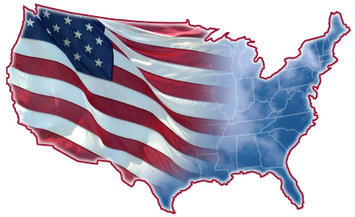
It’s interesting to look at 2000 presidential election results from some extreme counties, contrasting the most Republican and the Democratic areas, and compare them to some areas that voted 50:50 in 2004. I’ll look at 7 counties of each kind, illustrating the peculiar geography of American partisanship. The Republican and the Democratic areas will not change much, but it will be fascinating to see what happens to the even split areas of 2004. Do look them up in your road atlas and on the web for more detail!
Ultra Republican counties
The most extreme are all in the Great Plains or the Mountain West – not in the east. All are almost entirely white, most have more men than women (unusual in the US), have very high levels of traditional families, and most have fairly low levels of income inequality, reflective of cultural homogeneity.
These can be grouped into three sets:
- Madison and Franklin, ID, and Rich, UT, (all close together);
- Grant, NE, and Garfield, MT; and
- Ochiltree, TX, and Beaver, OK, (also close to each other).
The Idaho and Utah counties are similar in many ways, but the key characteristic is the dominance of the Mormon Church – no cultural ambiguity here! Rexburg, in Madison County, has a branch of Brigham Young University. Garfield and Grant typify the extremely low density and declining farm counties of the Plains and interior West, with a fiercely independent “western” image. Ochiltree and Beaver are in the Panhandle and also low density oil and gas and range economies. These are the rural, culturally conservative small towns that Sarah Palin would consider “real” America. Conspicuously absent are any counties that we would associate with the traditional image of rich suburbia and exurbia!
Ultra Democratic Counties
The extreme Democratic counties are not quite so extreme as their Republican counterparts. These counties are comprised of two somewhat distinct types – the cores of giant metropolitan areas, exemplified here by New York City, San Francisco and Washington, DC, and then the areas of very high concentrations of minorities.
Claiborne, MS, (in the Mississippi delta) and Macon, AL (home of the Tuskegee institute), are highly Black. Menominee, WI, has a high concentration of Native American Indians, while Prince George’s County, MD, is both a large metropolitan suburban county (of Washington DC) and is majority Black. In contrast to the ultra Republican counties, these are all rather low in non-Hispanic whites, low in traditional families, but high in singles and partners. Most have high inequality, with societies bifurcated between the rich and the poor.
The 50:50 balanced set is more complex and diverse. Some are in the South, with their fairly high minority shares balancing their likely cultural conservatism – Tensas, LA, (Mississippi delta), and Bladen, NC, (SE, food processing industry).
Three are small city or small metropolitan Midwestern counties with diverse economies – rich agriculture, urban industry: Peoria, IL, Winneshiek, IA, and Nicollet, WI.
Similarly, Monroe, PA, (Pocono mountains, tourism and exurban living), and Rensselaer, NY (Troy, Rust Belt, but some recovery) have both traditional conservative rural-oriented residents and liberal who have moved in from the New York Megalopolis. They tend to be intermediate between the very Republican and very Democratic areas in household structure, degree of inequality, with perhaps a little higher portion of the population engaged in manufacturing.
These sample areas reinforce the conventional wisdom of a polarization, at the extremes, between a metropolitan Democratic base, high in minorities, and a rural-small-town Republican base of traditional “values”. The small city, small metropolitan belt, mainly across the North, is amazingly balanced, and not surprisingly, the major battleground in this election. Big cities may talk a lot about diversity, but it’s largely in these smaller towns, as well as some exurbs and suburbs, where the real political debate about our future now takes place.
Richard Morrill is Professor Emeritus of Geography and Environmental Studies, University of Washington. His research interests include: political geography (voting behavior, redistricting, local governance), population/demography/settlement/migration, urban geography and planning, urban transportation (i.e., old fashioned generalist)












